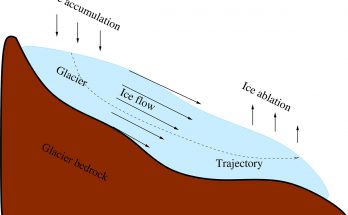Cette publication est également disponible en :
![]() Français
Français
Interview with Gerta Keller about her conference in Lausanne: Dinosaur wars: how Deccan volcanism trumped the meteorite.
Prof. Gerta Keller gives us her thoughts on some current issues, on the scientific controversies that continue to agitate her field and on her own scientific approach.
Are observations you made on climate and ecosystem changes at K-Pg transition time similar to those that are observed today? To which extend do you think there is a parallel between Cretaceous extinctions and today’s situation?
Gerta Keller : Yes, the situation seems very similar, except that nowadays the climate change is really faster. During the Cretaceous, volcanoes released a large amount of CO2 into the atmosphere. This induced global climate warming and ocean acidification. That is exactly what is observed today around the world. During the KPB mass extinction, an increase of 2° Celsius in less than 1’000 years lead to the climate tipping point causing the mass extinction. Today, we are on the way to achieve 1.5-2° warming in 30-50 years. We have already lost an estimated 50% of the biodiversity. We don’t see it because it concerns mostly species that are not visible, such as bacteria, fungi, and other microorganisms plus much of the marine life in oceans and seas. We are on the way to the next major mass extinction, caused by mankind; it will mark the 6th mass extinction in Earth’s history and we may be the dinosaurs of this mass extinction.
What do you think about the COP26 conference?
GK : I think that there was no progress made at this conference. That was disappointing because all the elements were there to show that something has to be done and quickly. People ae not ready to understand that we are at a critical point and the real consequences of global warming on the environment and society are very grave. I am very pessimistic about the future with risks of the rising sea level, submerging coastal cities, big loss of land for cultivation leading to starvation and consequently migrations fueled also by climate warming. As long as the few super-rich can influence the debate according to their own interest and well-being, it will be difficult to move things along and safe our planet.
In the title of your seminar you used the term Dinosaur “wars”: why? and why is this controversy still debated so intensively today ?
GK : LeThe four decades long investigation of the end-Cretaceous mass extinction was indeed, and still is, long-term science warfare. Virtually all sciences have encountered such acrimonious warfare over the centuries. So, though rare, this is not unusual and each such long-term ‘warfare’ seems to follow the same blueprint (described by Thomas Kuhn, 1962, Structure of Scientific Revolutions; Lee Smolin, 2006, The Trouble with Physics). The war always concerns a popular topic and the dominant group fights for fame, glory and power corrupting evidence that doesn’t fit. Today, this war involves fossil fuel industry, big business, the billionaires that made their money in the fuel industry, politics and government. In the science it comes down to fighting truth with lies. The Dinosaur Wars follow the same patterns described by Kuhn and also Smolin. The reason the debate is still continuing today is the escalation of climate warming due to humans’ fossil fuel burning, our impending mass extinction caused by mankind, and the climate warming deniers. This climate warming catastrophe has been recognized since officially since 1980 and nothing has been done to rain in the greenhouse gas escalation (CO2) – not even the 2021 United Nations Glasgow Climate Conference could reach a solution that has teeth in to slow down, and better yet eliminate the rapid rise of climate warming that leads us into the next mass extinction well before the end of this century.
Why did you doubt the impact theory so early and so firmly?
GK : In the 1980’s, I was already conducting research on the dinosaur mass extinction. I was looking for evidences of climate and environmental changes that could explain extinctions. When I heard about the Alvarez’s impact theory, I wanted to find evidence that supported the proposed meteoritic impact. But found none. On the contrary, I found elements that were inconsistent with it. For example, I observed impact glass spherules, which originated from an impact, well before the mass extinction and also well above it separated by 100,000 to 300,000 years. The oldest and primary impact layer in the Cretaceous predated the mass extinction by 200-300 thousand years. Subsequent spherule layers were eroded from the primary deposit over time by currents and re-deposited still below the mass extinction and in other areas well after the mass extinction by the Gulf Stream current. It was clear that the impact was not the cause of the KPB mass extinction. There had to be another catastrophe. This impact spherule evidence didn’t fit the impact theory and was therefore dismissed.
In the 1980s, another scientist, Dewey McLean, had already proposed that the massive extinction could be attributed to very high volcanic activity in the Deccan Volcanic province of India. This was more in agreement my research results. Over the past 15 years, my research focused on volcanism in India and its effects on climate, environmental changes and the mass extinction.
Do the evolution of methods and technics help bring about strong supporting evidence for your theory?
GK : Yes, absolutely. For example, the Deccan traps major lava flows are linked to high volcanic activity but no age dating has been possible. To understand the environmental influence of volcanism and its relationship to the mass extinction, we needed to date the lava layers. One of my colleagues at Princeton, Blair Schoene, is expert in using Uranium-Lead dating based on zircon crystals commonly found in volcanic ash, but such ash layers were rare in Deccan volcanism. We searched for zircons in redbole clay layers between lava flows with success and were able to age dating the time line of volcanic eruptions and the position of the mass extinction in the 3400m high lava mountains. The next step was to link the catastrophic lava eruptions to the mass extinction worldwide using mercury fallout from the volcanic plumes that distributed Hg worldwide. By measuring the mercury fallout in Tunisia, Israel, Mexico and many other localities we could link it back to the volcanic lava flows in the Deccan Traps based on the zircon dating and the biostratigraphy and orbital cyclicity age control of the sediments. The results yielded excellent age control worldwide linking the mass extinction catastrophe directly to the most massive pulse of Deccan volcanic eruptions in India. This left no doubt that the mass extinction was closely related to the massive Deccan volcanism, its high toxicity, rapid climate warming and ocean acidification.
You say that the phenomenon of extinction took place gradually (over thousands of years). Why did so few species manage to adapt to this “slow” climate change?
GK : Thousands of years is not a long time when it comes to mass extinctions – indeed it’s rather fast on a geological time scale. When paleontologists talk about “gradual extinctions”, they mean it lasted over tens to hundreds of thousands or more years. The “gradual” change refers to long-term climate and environmental changes that left their imprint on species populations that decreased often terminally because they couldn’t adapt to the changes. Species can do small quick adaptations which correspond to “stress adaptation”, which allow species to survive short term. During the K-P mass extinction, frequent massive volcanic activity with its toxicity and extreme climate warming quickly led to the extinction of all specialized large species that had already successively decreased and weakened during the preceding 200,000 years. Only a small group of small environmentally adapted species survived the mass extinction for a short time interval, leaving just one survivor species, known as a disaster opportunist (Guembelitria cretacea) that thrived when other species couldn’t.
Is there a further (or last) element that you wish to find to strengthen the evidence for your theory?
GK : Yes, absolutely:
- Prove the age of the Chicxulub impact predates the mass extinction by about 200,000 years.
- Determine the origin of the iridium anomaly at the KP boundary mass extinction: was it impact or volcanism?
References
- Kuhn, Thomas S. (1962). The Structure of Scientific Revolutions (1st ed.). University of Chicago Press.
- Smolin, Lee. (2006). The Trouble With Physics: The Rise of String Theory, the Fall of a Science, and What Comes Next. Houghton Mifflin.


